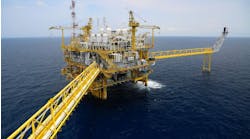Natural gas accounts for about one-third of discovered resources often associated with oil in deepwater fields. The major question is: what to do with the gas? This thesis was presented in a technical paper delivered by Paul Harald Kongelf of Aker Maritime at the recent Deep Offshore Technology conference in Stavanger, Norway.
"Is associated gas an asset or burden?" Kongelf asked. The question is especially applicable to the current environment in the deepwater Gulf of Mexico.
Flaring is not a practical option even in those areas where it is allowed. The fines for carbon dioxide emissions easily outweigh the benefits. Re-injection is a popular option but it carries its own set of liabilities. Among these are the need to dehydrate the produced gas, re-compress the dried gas, add reinjection compressors to topsides as well as re-injection risers, build re-injection infield pipelines and drill re-injection wells. The costs associated with these programs often defeat the enhanced recovery they may provide.
Kongelf identified the traits of an ideal associated-gas process. It must be effective, insensitive to the quality of the feedstock, cheap, safe, simple, small, and light (compact), insensitive to motion, flexible in the sense that it can be made into modules, easy to scale (to align with available recoverable gas reserves), and the product must be cheap and simple to transport to the market.
While this is a tall order, Kongelf listed the options, besides flaring and re-injection that currently show the most potential. They are as follows:
- Burn the gas to make electricity offshore, combined with the injection of nitrogen and carbon dioxide
- Construct a pipeline to move the gas to shore
- Compress the natural gas (CNG)
- Transport the gas in a hydrate phase
- Conduct small scale LNG offshore
- Convert the gas to liquids (Syncrude/ Synfuel - GTL by FT)
- Convert the gas to methanol (raw, grade A/AA)
- Convert the gas to olefins (MTO)
Most of these technologies are still in the development stage or would need dramatic cost reductions to provide a practical offshore solution. Kongelf seems confident that several may become viable in the near term (3-5 years). While associated gas in deepwater fields is currently a burden, Kongelf said he believes advancing technology will eventually turn the tables making it an asset.


